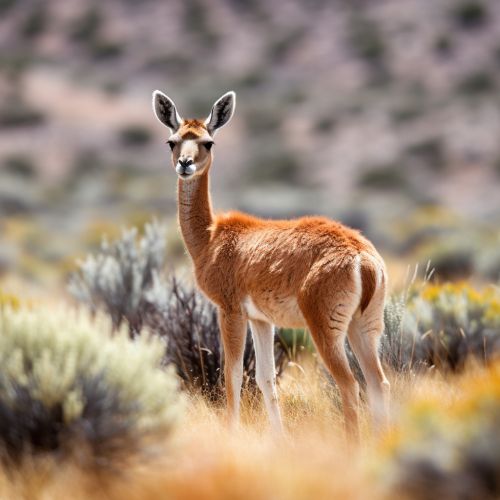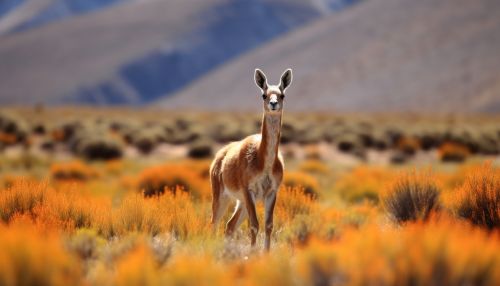Vicuna
Taxonomy and Evolution
The vicuna, or Vicugna vicugna, is one of two wild South American camelids, the other being the guanaco, which live in the high alpine areas of the Andes. They are relatives to the llama and the alpaca. The vicuna is the national animal of Peru and appears in the Peruvian coat of arms.
Vicunas are believed to be the wild ancestors of alpacas, which were domesticated more than 6000 years ago by the ancient tribes of the Andean highlands. The vicuna's scientific name, Vicugna vicugna, is derived from the Quechua word wik'uña, which means "small camel".


Physical Characteristics
Vicunas are small and slender animals, with a body length of 80 to 130 cm (31 to 51 in), and a shoulder height of 75 to 85 cm (30 to 33 in). They weigh between 40 and 50 kg (88 to 110 lb). They have a long, slender neck and a short, pointed muzzle. The vicuna's coat is a warm, light brown on the upper body, while the underparts and the insides of the legs are white. The coat is made up of two types of fiber: a soft, dense undercoat, which provides insulation against the cold, and a layer of long, coarse guard hairs.
Habitat and Distribution
Vicunas inhabit the high alpine areas of the Andes, ranging from southern Peru to northern Argentina and Chile. They are found at altitudes of 3200 to 4800 m (10,500 to 15,700 ft) above sea level. The vicuna's habitat is characterized by a cold, dry climate with a mean annual temperature of -1 to 5 °C (30 to 41 °F) and annual precipitation of 200 to 400 mm (7.9 to 15.7 in).
Behavior and Ecology
Vicunas live in family groups that consist of a dominant male, several females, and their young. They are active during the day, feeding in the morning and late afternoon, and resting during the heat of the day. Vicunas are herbivores, feeding mainly on grasses and other small plants found in the high Andes.
Vicunas have a number of adaptations to their harsh environment. They have a highly efficient respiratory system to cope with the thin air at high altitudes. Their woolly coat provides excellent insulation against the cold, and their large, padded feet allow them to move easily over the rocky terrain.
Conservation
Vicunas were heavily hunted for their fine wool, which was more valuable than gold during the Inca Empire. By the 1960s, the vicuna population had declined to around 6,000 individuals. However, conservation efforts have been successful in increasing the population to around 350,000 individuals today. The vicuna is currently listed as Least Concern by the IUCN.
Economic Importance
The vicuna's fine wool, known as vicuna fiber, is one of the rarest and most expensive natural fibers in the world. It is used to make high-end clothing and textiles. The fiber is collected through a process known as shearing, which is carried out every two to three years. The vicuna is protected by law in all countries where it lives, and the commercial use of vicuna fiber is strictly regulated.
